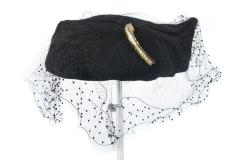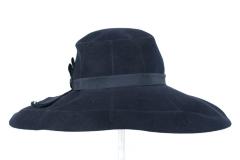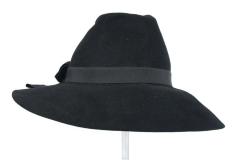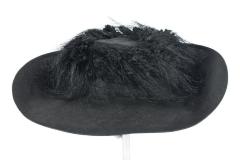Comments and Tags
Be the first to comment on this item!
Clothing and Accessories
Women's Clothing
Voigt Family Collection
Clothing Accessories
Headwear ➔ Cap and Box
Identifier:
V2017.1.399Description:
This cap is made of satin and lace and is decorated with a white ostrich feather and fabric flowers. There are velvet ribbons on both sides of the cap that tie underneath the chin to help keep the cap in place. There is also a comb on the inside of the cap to help hold in in place. It was stored in a Marshall Field and Company box. This cap was worn by Elizabeth Voigt of Grand Rapids, Michigan.The photo is of Elizabeth Voigt and her husband Carl G.A. Voigt.
Date:
circa 1895 – 1908Materials:
Lace, Sequins, Ostrich Feather, SilkDimensions:
6"" h 7"" w 7"" d; 7"" h 12"" w 10"" dCollection Tier:
Tier 2Source:
Gift Of Kent County Council For Historic PreservationRelated Entities:
Elizabeth S. Voigt (used by)Mrs. Elizabeth S. Voigt was the wife of Charles (Carl) G.A. Voigt and the co-founder of the Voigt-Herpolsheimer Company and the Voigt Milling Company. Mrs. Voigt was born in Ann Arbor, Michigan on July 6th, 1841. She was the daughter of Mr. and Mrs. John Conrad Wurster. In 1855 she and her family moved to Michigan City, Indiana. In 1857, Mrs. Voigt came to the Grand River Valley for the first time, traveling by stagecoach over the old Kalamazoo plank road. While visiting friends here she was captivated by the natural beauty of the country; she was a lover of flowers and nature. She returned to Michigan City, however, and in 1860 married Mr. Voigt, who, at the time, was managing a dry good store there. In 1865 Mr. Voigt went into business for himself and founded the Voigt Dry Goods Company. The store prospered and soon afterward William G. Herpolsheimer, a fellow employee, joined Mr. Voigt. The concern expanded soon after the partnership was established in Grand Rapids. It was known as the Voit-Herpolsheimer Company and was located at 42 Monroe Ave. In 1875, Mr. and Mrs. Voigt came to Grand Rapids. Mr. Voigt retained his interest in the dry goods business but soon acquired the Star Milling Company and started a business as C.G.A. Voigt & Co. In 1882, the Crescent Mill was purchased and in 1896 the two mills were merged to form the Voigt Milling Company. In 1902 Mr. Voigt and Mr. Herpolsheimer dissolved their partnership by verbal agreement. Mr. Voigt kept the mills and Mr. Herpolsheimer kept the dry goods store. Charles died in 1908 and the milling business was incorporated. Mrs. Voigt was named vice president and was active in the affairs of the company until death. Besides being active in the flour milling business, she was involved or had interests in music, church work, and her home. Her home was her club and she was always active in the care of her family. She was widely known for her kindness and philanthropies. On May 11, 1929, she died at her home, 115 College Ave. S.E., at the age of 87 years old. Voigt House (used by)
Alternate names: Voigt Family
The Voigt family, whose home is now preserved by the Grand Rapids Public Museum, moved to the city in 1875 and resided at 133 Court Street (now Scribner Street). The Voigt family partnered with the Herpolsheimer family in the dry-good and carpet business and in a few years the partnership expanded to include two flour mills -- the Crescent and Star mills located on the Grand River. In 1902 the partnership came to a mutual end. The Herpolsheimer family retained the dry-good store and the Voigt family kept the two mills. By the turn of the century, Voigt flour under several brand names, and later Voigt Cereal, were known across Michigan and far east as New England. Due to bankruptcy and a strike, the flour milling business came to an abrupt end in 1955. In 1895, Carl G.A. Voigt hired local architect William G. Robinson to design a house on 115 College Avenue Southeast to serve as his retirement home. It was modeled after the chateaux at Chenoceaux, France. The home is a fine example of Victorian architecture and complemented the Victorian family that lived in it. It was lived in by just the Voigt family which was comprised of Carl Gustav Adolf Voigt, his wife Elizabeth Wurster Voigt and their children. They were the parents of nine children with six surviving until adulthood. The family lived in the home from 1895 to 1971. Kent County Council for Historic Preservation (donor)
The Kent County Council for Historic Preservation has several responsibilities that support the preservation and protection of our history. These include:
- Recommending designation of new historic districts
- Reviewing applications for proposed alterations within historic districts
- Enforcing the Historic Preservation Ordinance Chapter and cooperating with the state, federal and local governments in pursuance of its responsibilities
- Conducting meetings or hearings necessary to carry out these purposes
The Historic Preservation Commission consists of seven members who reside in Grand Rapids. Members are appointed by the City Commission for three-year terms (two consecutive terms are allowed). Members shall have a demonstrated interest in or knowledge of historic preservation. Two members shall be appointed from a list submitted by the Kent County Council for Historic Preservation and one member shall be an architect duly registered in the State of Michigan.
http://grcity.us/design-and-development-services/Planning-Department/Pages/Historic-Preservation-Commission.aspx



